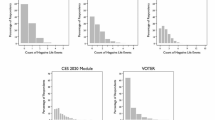Abstract
This article describes a post-electoral cross-sectional survey conducted after the French presidential election of 2017. The French Election Study consists in a national representative sample of 1830 people, who were interviewed face-to-face in the days following the second round. The paper introduces the questionnaire and the methodology used. Data quality is also discussed in comparison with previous French cross-sectional presidential election studies.
Similar content being viewed by others
Notes
A number of projects have also collected opinion data for the 2017 presidential election. For the project we are aware of, CEVIPOF has fielded a massive online panel covering almost 2 years (from November 2015 to July 2017, see https://www.enef.fr/); the long-term panel Dynamob (Electoral choices and political values: 2013–2017) has also included systematic questions before and after the election (http://quanti.dime-shs.sciences-po.fr/en/). The Comparative National Election Project (CNEP) fielded a specific survey as well (https://u.osu.edu/cnep/).
A team of about 20 researchers has been associated with the project. We especially thank Abdelkarim Amengay, Bruno Cautrès, Mirjam Dageforde, Anja Durovic, Romain Lachat, Nonna Mayer, Florence Nocca, Jan Rovny (from Sciences Po Paris), Viviane Lehay and Vincent Tiberj (from Sciences Po Bordeaux), Chloé Alexandre, Sandrine Astor, Céline Belot, Pierre Bréchon, Frédéric Gonthier, Cal Le Gall, Raul Magni-Berton, Corentin Poyet, Max-Valentin Robert, Sonja Zmerli (from Sciences Po Grenoble), Camille Bedock (Université Libre de Bruxelles), Charlotte Dolez (Université Catholique de Louvain), Filip Kostelka (Université de Montréal) for the invaluable contribution to the project they provided.
Continental France is the national territory except for overseas territories and Corsica. These territories are usually excluded from face-to-face surveys for cost reasons. Metropolitan France only excludes overseas territories.
See Sauger (2008) for a discussion of these aspects in the context of quota sampling.
References
Akkerman, A., C. Mudde, and A. Zaslove. 2014. How Populist are the People? Measuring Populist Attitudes in Voters. Comparative Political Studies 47(9): 1324–1353.
Assael, H., and J. Keon. 1982. Nonsampling vs. Sampling Errors in Survey Research. Journal of Marketing 46(2): 114–123.
Biemer, P.P., and L.E. Lyberg. 2003. Introduction to Survey Quality. Hoboken: Wiley.
Durier, S., and Touré, G. 2017. Elections 2017: 6, 5% des citoyens ont fait une demarche volontaire pour s’inscrire. Insee Focus 80. https://www.insee.fr/fr/statistiques/2649341#documentation. Accessed 8 Aug 2017.
Farrell, J.J., and P.R. Laughlin. 1976. A Scale to Measure Populist Attitudes. The Journal of Psychology 94(1): 33–38.
Gosling, S.D., P.J. Rentfrow, and W.B. Swann. 2003. A Very Brief Measure of the Big-Five Personality Domains. Journal of Research in Personality 37(6): 504–528.
Gschwend, T. 2005. Analyzing Quota Sample Data and the Peer-Review Process. French Politics 3(1): 88–91.
Hobolt, S.B., E. Anduiza, A. Carkoglu, G. Lutz, and N. Sauger, 2016. CSES Module 5 Stimulus Paper: Democracy Divided? People, Politicians and the Politics of Populism. Retrieved from http://www.cses.org/plancom/module5/CSES5_ContentSubcommittee_FinalReport.pdf.
Mayer, N., and N. Sauger. 2012. Comportement électoral et grandes enquêtes. In La France dans les comparaisons internationales, ed. L. Lesnard and A. Chenu, 31–48. Paris: Presses de Sciences Po.
Morin-Chassé, A., D. Bol, L. Stephenson, and S. Labbé St-Vincent. 2017. How to Survey About Electoral Turnout? The Efficacy of the Face-Saving Response Items in 19 Different Contexts. Political Science Research and Methods 5(3): 575–584.
Sauger, N. 2008. Assessing the Accuracy of Polls for the French Presidential Election: The 2007 Experience. French Politics 6(2): 116–136.
Schulz, A., P. Müller, C. Schemer, D.S. Wirz, M. Wettstein, and W. Wirth. 2017. Measuring Populist Attitudes on Three Dimensions. International Journal of Public Opinion Research. doi:10.1093/ijpor/edw037.
Weisberg, H. 2005. The Total Survey Error Approach. Chicago: University of Chicago Press.
Zeglovits, E., and S. Kritzinger. 2014. New Attempts to Reduce Overreporting of Voter Turnout and Their Effects. International Journal of Public Opinion Research 26(2): 224–234.
Acknowledgements
We thank all our colleagues from Sciences Po Paris, Sciences Po Grenoble, Sciences Po Bordeaux and elsewhere for their participation in the project. We also thank Sciences Po Paris, Université Grenoble Alpes, LIEPP (ANR-11-LABX-0091, ANR-11-IDEX-0005-02) and the National Research Foundation of Korea (Grant No. 2014S1A3A2044032) for their financial support.
Author information
Authors and Affiliations
Corresponding author
Rights and permissions
About this article
Cite this article
Gougou, F., Sauger, N. The 2017 French Election Study (FES 2017): a post-electoral cross-sectional survey. Fr Polit 15, 360–370 (2017). https://doi.org/10.1057/s41253-017-0045-6
Published:
Issue Date:
DOI: https://doi.org/10.1057/s41253-017-0045-6




